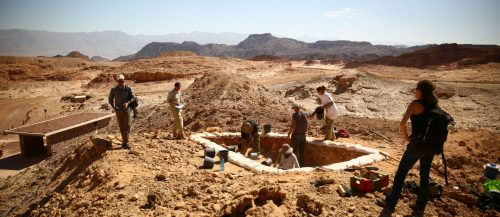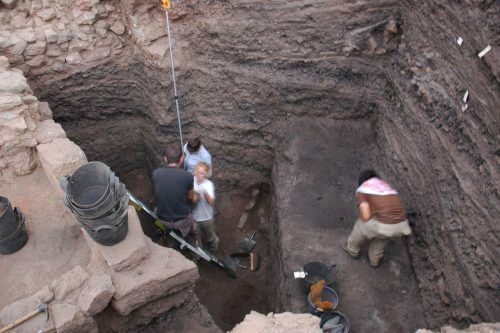Researchers: Evidence was found for a technological and social leap in biblical Edom after Pharaoh Shishak's journey to the Arabah in the 10th century BC * Prof. Erez Ben Yosef from Tel Aviv University who headed the study: "Egyptian intervention turned Edom into the greatest copper power in the ancient Near East" * The study will be published Tonight (18.9) in the journal PLOS ONE

An archaeological study unprecedented in its scope, led by Prof. Erez Ben Yosef of the Department of Archeology and the Ancient Near East from Tel Aviv University, in collaboration with the University of California, San Diego, revealed the story of the growth of the biblical kingdom of Edom through a careful analysis of the waste from the copper industry in the Arabah. The researchers analyzed hundreds of findings from the ancient copper mines in Jordan (Finan) and Israel (Tamna) in order to reconstruct the development and perfection of the copper production industry over about 500 years, around the beginning of the first millennium BC (ie between 1300 BC and 800 BC) . Through microscopic and chemical tests of copper slag, dramatic technological changes were detected with high time resolution.
"There are researchers who are trying to dwarf copper production in the Arava region during this period," explains Prof. Ben Yosef. "According to them, this is a loose collection of tribes that produced copper in a temporary and random manner. Our findings contradict this concept and are in line with the biblical story according to which there was a kingdom in the region "before a king-king, for the children of Israel" (Genesis XNUMX). The evidence we found for the copper industry in the Arabah can only be attributed to a centralized and hierarchical kingdom, that is, to that ancient and biblical Edom."
Copper, which was used in ancient times to produce tools and weapons, was the most valuable resource in the societies of the ancient Near East. Copper production is a complex process, requiring different stages and different levels of expertise: the copper potter had to build a furnace of very specific dimensions, supply this furnace with a precise amount of oxygen and coal, maintain a temperature of no less than 1,200 degrees Celsius, pour in a constant amount of air and add to the cauldron a complex mixture of minerals.

A technological leap sponsored by the Egyptians
"It was the 'high-tech' of ancient times, and like today it employed experts who regularly engaged in 'research and development'. Technological achievements were kept as a professional secret, and the management of the industry was directly related to the ruling elite. Accordingly, the way technology is applied and changes in its effectiveness over time reflect social processes, and our results show for the first time the time and manner in which a complex society appeared that weakened the entire space. This society is identified with the biblical Edom, which according to the Bible was conquered and enslaved by Israel in the days of David. Analyzing the development of technology through evolutionary models shows that the most significant change occurred as a result of Egyptian intervention in the region during the time of Pharaoh Shishak, in the second half of the 10th century BC and a ball or two after David's conquests.
In their new study, Prof. Ben Yosef and his team chemically and microscopically analyzed copper slag - that is, the waste from the furnaces - and were able to show a clear statistical drop in the amount of copper in the slag, meaning a jump in the efficiency of the production process. Archaeologists attribute this leap to the military campaign of Pharaoh Shishak - the first event in the Bible (XNUMX Kings XNUMX) that is also described outside the Bible: on the walls of the Karnak temple in Egypt.
"We showed a sudden standardization of the slags, from Pinan in Jordan to the Arabah in Israel, i.e. at the same time over an area of about 2,000 square kilometers, which occurred exactly at the time attributed to the Egyptian intervention in the area - in the second half of the 10th century BC," says Prof. ' Ben Yosef.
"Suddenly, the efficiency of the copper industry in the region is increasing, an efficiency that indicates work according to precise protocols that allowed the production of a very large amount of copper with minimal energy. It should be understood that Egypt during this period was weak, and the Egyptians were not the ones who managed the industry, but they shocked Edom - which may have been still enslaved to Israel at that time - in a way that led to the technological leap. As consumers of imported copper, the Egyptians had a distinct interest in streamlining industry in the Arabah, and it seems that through their long-range connections they were a catalyst for the Red adoption of technological innovations from the entire region. For example, the camel appears for the first time in our region immediately after the Shishak campaign, and also in connection with copper - as a means of streamlining trade in the desert areas where it was produced. In fact, the Egyptian intervention turned Edom into the greatest copper powerhouse in the ancient Near East."
More of the topic in Hayadan:
The metal workers in the mines of Timna lived like kings
A historical discovery for researchers from Tel Aviv University: The King's Mines in Timna Park - from the days of King Solomon
We will be strangers to you, Israel - Part XNUMX

2 תגובות
Dear Gideon,
The story of our father Abraham as told in the Bible is a story, not history. As well as the description of King Solomon as a wise man and ruler of a mighty kingdom.
and write conclusions in K.
Dear friend, improve your knowledge!
Forgive me but your poor things are Egyptian nonsense from the time of Shishak.
Improving the copper production process was done by King Solomon, which led Ben Hiter to spread his wisdom throughout the region and beyond.
At all, if the border appeared here, according to you, after the Shishak campaign, that is, after King David. So where did the camels of our father Abraham come from that were taken by Eliezer, they were worshiping the light of the Chaldeans to bring a bride to his son Isaac.
Dear friend, improve your knowledge 🙂